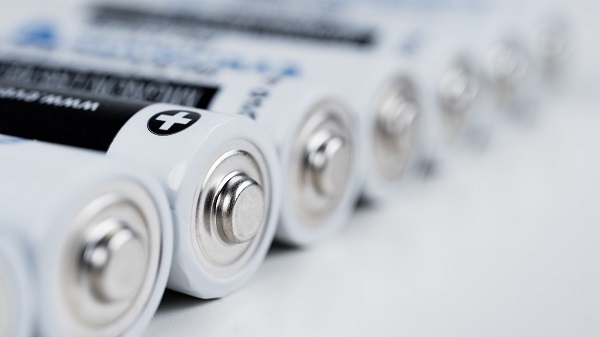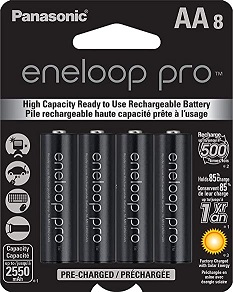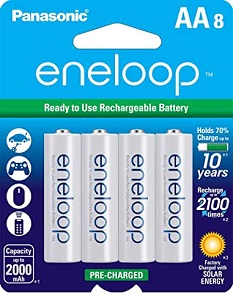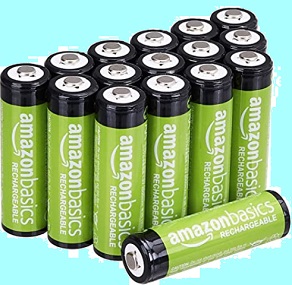This article came about because of an article I read called, "The Best
Rechargeable AA and AAA Batteries for All of Your Old Electronics" by
Andrew Heinzman. It was written for the ReviewGeek December 18, 2019,
9:00am EDT issue. The link for the original article is:
The Best Rechargeable AA and AAA Batteries for All of Your Old Electronics

by: Andrew Heinzman * December 18, 2019, 9:00am EDT
Now, why should I write another article about this topic? Well, after reading the article I felt that there were two major omissions in Mr. Heinzman's article. The first was a list of battery criteria that the author used to determine which batteries were the best. The second was that the author did not take into account the problems that can occur when using rechargeable batteries in electronics not designed to use rechargeable batteries.
In this article I will give the list of criteria I used to determine which rechargeables were the best for my needs, and I will explain the problems I've encountered when using rechargeable batteries for devices not designed with such batteries in mind.
The one-third rule of battery life: When the batteries are down by 1/3rd of their original voltage, then the battery is considered dead. For devices that use this "rule," using a rechargeable battery is probably safe. There are exceptions. Assuming that the starting voltage is 1.5 V, this means that the dead voltage is around one Volt. This means that a 1.2 Volt Rechargeable Battery (RCB) will have a much shorter "life" for powering the device.
I remember a time when Radio Shack made large handheld CB Walkie Talkies (WTs) that could use either 1.5 or 1.2 Volt batteries. When using the 1.2 Volt NiCd batteries, the user needed ten of these to make up the needed 12 Volts for the WT, but when using 1.5 Volt batteries, the user only needed eight batteries to get to the needed 12 Volts. To this end, Radio Shack included two blank (short-circuit) dummy batteries for the two empty places when using non-RCBs.
So, problem #1 is a lower starting voltage unless, as in the case of the Radio Shack WTs, the manufacturer plans for their use.
Problem #2: If there was no plan to use RCBs, then the older device now using them will have a shorter useable time. I came across this issue when using an mp3 player from the library. It expected a 1.5 Volt AAA non-RCB; when I used a RCB, it only lasted an hour of playing time before I needed to replace the battery. Most of the time, the library book mp3 players were able to use one AAA RCB for the entire book. This one was an exception, but it would not work for something like that.
Problem #3: This one can be imagined when using RCBs in a device that used non-RCBs and didn't care how low the voltage would get. In this case, the more expensive RCB could be damaged and end up no longer able to hold a charge. This could happen, for instance, if we tried to use RCBs in an older flashlight that did not care how low the battery went. It was up to the user to replace the batteries when the light was too dim to be useful, and this could be a voltage too low for the RCBs.
Now here's another point about flashlights: Some of the newer, small flashlights can drive a non-RCB down to well below the safe voltage of an RCB, and so an RCB should never be used in this newer-designed flashlight. These are the one AAA battery-type of LED flashlight. These use a voltage booster circuit and will boost even a battery at around half a volt (0.5 V) to be bright enough for use. Some voltage-boosting circuits I've designed for a battery night-light can go down below a quarter of a volt and still be useful, if a bit dim.
Devices which are not designed to use an RCB are not monitoring the battery voltage, so unless the voltage of the "dead" battery is within the safe discharged voltage of the RCB, an RCB should not be used.
To review: If an RCB is placed into a device which discharges a single-use battery much below one volt, then there is the possibility that the RCB will be destroyed. This ends up being a rather expensive learning curve, and I've seen people get really angry at having paid so much for only a single use out of what was supposed to be a rechargeable battery, never understanding why the RCB failed.
Second, the device's shut-down voltage is right around 1.2 Volts (per RCB), and so NiMH type batteries can't be used at all because they have an extremely short "life span" in such devices. In this case, the RCB is not hurt at all; it is just a very bad battery to use in such a device.
Now let's consider the criteria for selecting which RCB is the "Best."
When I was experimenting with a voltage booster circuit, I had to decide on what I considered the "best" circuit. The qualities I considered were:
Now, for batteries the list I came up with is:
Now let's look at a real case scenario for selecting the best battery for our needs. In my case I was considering first and foremost my amateur radio emergency hand-held radio go-kit power source. It needs to be reliable, with a long self-life, low self-discharge, high number of charge cycles, and battery-to-battery reproducibility and repeatability. So I needed #2, 1, 4, 5, 6, 7, and last #3. Number 3 - cost - is on my list of criteria but for emergency service it is not as important as the other criteria.
I traded off a bit of number one for the great increase in number two. I bought the lower-capacity eneloop batteries because the top-of-the-line only had 500 charge cycles. I chose the lower mAh, 1900 - 2000 mAh, because they could be recharged up to 2100 times. I felt the loss of 20% duration was more than offset by the 400% increase in number of times they could be recharged. The price was $4.00 each for the top-of-the-line 8-pack:
For the lower-capacity higher-recharge-cycles version the cost was about $2.38 for each, just a bit more than half, so I could buy twice as many of these for almost the same and have a total of 3800 - 4000 mAh, a bit more than a 50% increase in run-time capacity, and more than 400% more charge cycles, all for just 19% more money.
Having to change batteries a little sooner, for the lower capacity batteries, was no real problem and one I was willing to trade for all the other gains using the lower-price, lower-capacity batteries.
I bought eneloop brand because of the manufacturer. I knew Panasonic makes both a reliable and a consistent product. In emergency radio communications those are two very important criteria. I made up for the lower operational life by buying enough batteries to satisfy my length of operational goals.
Also, both the cost and the number of recharge cycles were substantially better, in my opinion, to offset the 20% longer life for the top-of-the-line batteries.
My best battery for this particular scenario was the Panasonic BK-3MCCA8BA eneloop AA 2100 Cycle Ni-MH battery. What you select as your best battery may be completely different from my selection.
Let's try a different need. Assume you want to use the batteries in toys. What's important? I'd think that #3, 2, and 1 in that order. That's cost, number of recharge cycles, and capacity.
Let's look at the AmazonBasics AA rechargeable battery 16-pack:
First, the 16-pack makes each battery less than half the cost of their 8-pack. Next, these say they are 2000 mAh capacity: not bad for replacing Alkaline batteries, and about the same as the eneloop batteries I selected before. In a toy that is about the same useful life. The company claims a decent shelf life ~ 80% after two years. That's not bad, but for toys probably not nearly as important as run-time. They claim 1000 recharge cycles, which is about half of the eneloop batteries I selected for my use. The cost per Amazon battery was about $1.72. The cost of the eneloop was ~ $2.38, so about a 38% increase in cost but a better than 100% increase in number of times they can be recharged. I think I'd still buy the eneloop batteries with 2100 charge cycles for the toys. So, again, I think that for my purposes the eneloop 8 pack is still the best battery to buy.
Panasonic BK-3MCCA8BA eneloop AA 2100 Cycle Ni-MH
Rechargeable Batteries, 8 Pack
I'll leave it there. Using even this second, smaller set of criteria, the eneloop 2100 charge-cycles battery still out-performs the lower cost Amazon battery and, in the long run, costs less money, as long as you'll actually use them for about 2000 recharge cycles.
Until next time, Happy Battery use,
Phil Karras, KE3FL
The Best Rechargeable AA and AAA Batteries for All of Your Old Electronics

by: Andrew Heinzman * December 18, 2019, 9:00am EDT
Now, why should I write another article about this topic? Well, after reading the article I felt that there were two major omissions in Mr. Heinzman's article. The first was a list of battery criteria that the author used to determine which batteries were the best. The second was that the author did not take into account the problems that can occur when using rechargeable batteries in electronics not designed to use rechargeable batteries.
In this article I will give the list of criteria I used to determine which rechargeables were the best for my needs, and I will explain the problems I've encountered when using rechargeable batteries for devices not designed with such batteries in mind.
The one-third rule of battery life: When the batteries are down by 1/3rd of their original voltage, then the battery is considered dead. For devices that use this "rule," using a rechargeable battery is probably safe. There are exceptions. Assuming that the starting voltage is 1.5 V, this means that the dead voltage is around one Volt. This means that a 1.2 Volt Rechargeable Battery (RCB) will have a much shorter "life" for powering the device.
I remember a time when Radio Shack made large handheld CB Walkie Talkies (WTs) that could use either 1.5 or 1.2 Volt batteries. When using the 1.2 Volt NiCd batteries, the user needed ten of these to make up the needed 12 Volts for the WT, but when using 1.5 Volt batteries, the user only needed eight batteries to get to the needed 12 Volts. To this end, Radio Shack included two blank (short-circuit) dummy batteries for the two empty places when using non-RCBs.
So, problem #1 is a lower starting voltage unless, as in the case of the Radio Shack WTs, the manufacturer plans for their use.
Problem #2: If there was no plan to use RCBs, then the older device now using them will have a shorter useable time. I came across this issue when using an mp3 player from the library. It expected a 1.5 Volt AAA non-RCB; when I used a RCB, it only lasted an hour of playing time before I needed to replace the battery. Most of the time, the library book mp3 players were able to use one AAA RCB for the entire book. This one was an exception, but it would not work for something like that.
Problem #3: This one can be imagined when using RCBs in a device that used non-RCBs and didn't care how low the voltage would get. In this case, the more expensive RCB could be damaged and end up no longer able to hold a charge. This could happen, for instance, if we tried to use RCBs in an older flashlight that did not care how low the battery went. It was up to the user to replace the batteries when the light was too dim to be useful, and this could be a voltage too low for the RCBs.
Now here's another point about flashlights: Some of the newer, small flashlights can drive a non-RCB down to well below the safe voltage of an RCB, and so an RCB should never be used in this newer-designed flashlight. These are the one AAA battery-type of LED flashlight. These use a voltage booster circuit and will boost even a battery at around half a volt (0.5 V) to be bright enough for use. Some voltage-boosting circuits I've designed for a battery night-light can go down below a quarter of a volt and still be useful, if a bit dim.
Devices which are not designed to use an RCB are not monitoring the battery voltage, so unless the voltage of the "dead" battery is within the safe discharged voltage of the RCB, an RCB should not be used.
To review: If an RCB is placed into a device which discharges a single-use battery much below one volt, then there is the possibility that the RCB will be destroyed. This ends up being a rather expensive learning curve, and I've seen people get really angry at having paid so much for only a single use out of what was supposed to be a rechargeable battery, never understanding why the RCB failed.
Second, the device's shut-down voltage is right around 1.2 Volts (per RCB), and so NiMH type batteries can't be used at all because they have an extremely short "life span" in such devices. In this case, the RCB is not hurt at all; it is just a very bad battery to use in such a device.
Now let's consider the criteria for selecting which RCB is the "Best."
When I was experimenting with a voltage booster circuit, I had to decide on what I considered the "best" circuit. The qualities I considered were:
- Easy to build
- Brightness of the test LED
- Longevity of the battery
Now, for batteries the list I came up with is:
- mAh, capacity
- Number of recharge cycles
- Cost
- Reliability
- Reproducibility
- Repeatability
- Self discharge
Now let's look at a real case scenario for selecting the best battery for our needs. In my case I was considering first and foremost my amateur radio emergency hand-held radio go-kit power source. It needs to be reliable, with a long self-life, low self-discharge, high number of charge cycles, and battery-to-battery reproducibility and repeatability. So I needed #2, 1, 4, 5, 6, 7, and last #3. Number 3 - cost - is on my list of criteria but for emergency service it is not as important as the other criteria.
I traded off a bit of number one for the great increase in number two. I bought the lower-capacity eneloop batteries because the top-of-the-line only had 500 charge cycles. I chose the lower mAh, 1900 - 2000 mAh, because they could be recharged up to 2100 times. I felt the loss of 20% duration was more than offset by the 400% increase in number of times they could be recharged. The price was $4.00 each for the top-of-the-line 8-pack:
For the lower-capacity higher-recharge-cycles version the cost was about $2.38 for each, just a bit more than half, so I could buy twice as many of these for almost the same and have a total of 3800 - 4000 mAh, a bit more than a 50% increase in run-time capacity, and more than 400% more charge cycles, all for just 19% more money.
Having to change batteries a little sooner, for the lower capacity batteries, was no real problem and one I was willing to trade for all the other gains using the lower-price, lower-capacity batteries.
I bought eneloop brand because of the manufacturer. I knew Panasonic makes both a reliable and a consistent product. In emergency radio communications those are two very important criteria. I made up for the lower operational life by buying enough batteries to satisfy my length of operational goals.
Also, both the cost and the number of recharge cycles were substantially better, in my opinion, to offset the 20% longer life for the top-of-the-line batteries.
My best battery for this particular scenario was the Panasonic BK-3MCCA8BA eneloop AA 2100 Cycle Ni-MH battery. What you select as your best battery may be completely different from my selection.
Let's try a different need. Assume you want to use the batteries in toys. What's important? I'd think that #3, 2, and 1 in that order. That's cost, number of recharge cycles, and capacity.
Let's look at the AmazonBasics AA rechargeable battery 16-pack:
First, the 16-pack makes each battery less than half the cost of their 8-pack. Next, these say they are 2000 mAh capacity: not bad for replacing Alkaline batteries, and about the same as the eneloop batteries I selected before. In a toy that is about the same useful life. The company claims a decent shelf life ~ 80% after two years. That's not bad, but for toys probably not nearly as important as run-time. They claim 1000 recharge cycles, which is about half of the eneloop batteries I selected for my use. The cost per Amazon battery was about $1.72. The cost of the eneloop was ~ $2.38, so about a 38% increase in cost but a better than 100% increase in number of times they can be recharged. I think I'd still buy the eneloop batteries with 2100 charge cycles for the toys. So, again, I think that for my purposes the eneloop 8 pack is still the best battery to buy.
Panasonic BK-3MCCA8BA eneloop AA 2100 Cycle Ni-MH
Rechargeable Batteries, 8 Pack
I'll leave it there. Using even this second, smaller set of criteria, the eneloop 2100 charge-cycles battery still out-performs the lower cost Amazon battery and, in the long run, costs less money, as long as you'll actually use them for about 2000 recharge cycles.
Until next time, Happy Battery use,
Phil Karras, KE3FL
Return to the:


